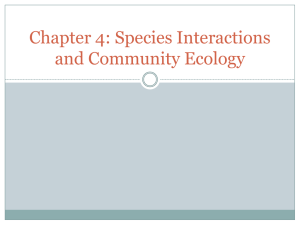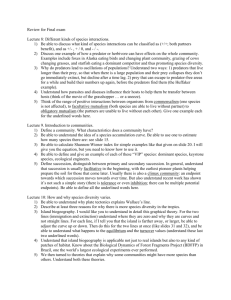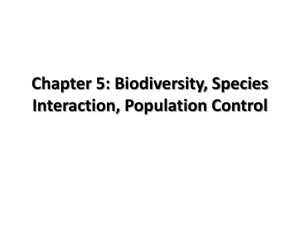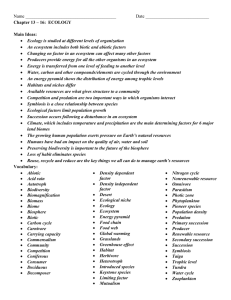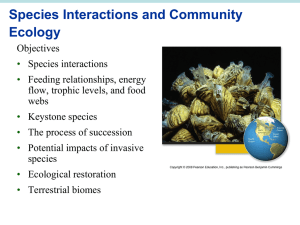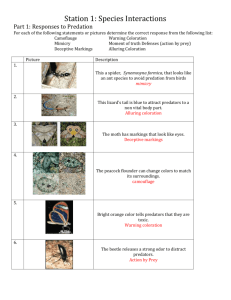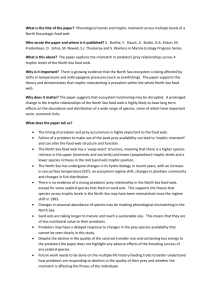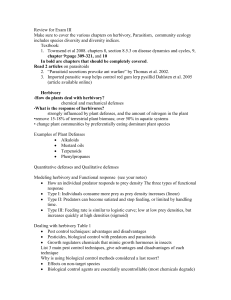Communities and Ecosystems
advertisement
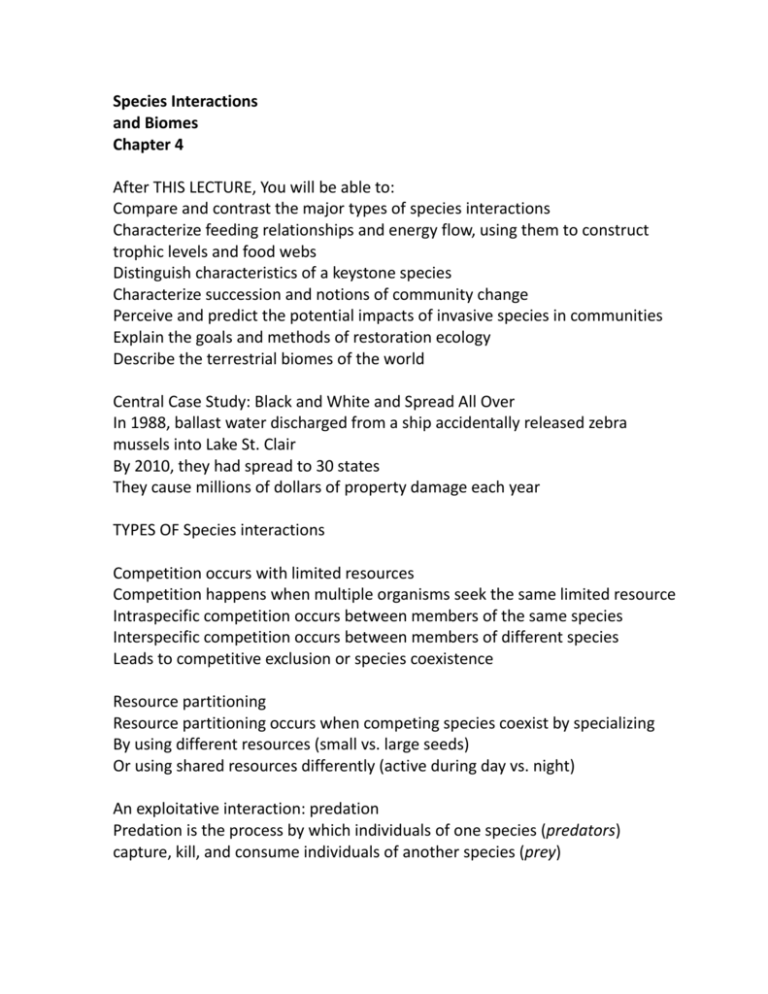
Species Interactions and Biomes Chapter 4 After THIS LECTURE, You will be able to: Compare and contrast the major types of species interactions Characterize feeding relationships and energy flow, using them to construct trophic levels and food webs Distinguish characteristics of a keystone species Characterize succession and notions of community change Perceive and predict the potential impacts of invasive species in communities Explain the goals and methods of restoration ecology Describe the terrestrial biomes of the world Central Case Study: Black and White and Spread All Over In 1988, ballast water discharged from a ship accidentally released zebra mussels into Lake St. Clair By 2010, they had spread to 30 states They cause millions of dollars of property damage each year TYPES OF Species interactions Competition occurs with limited resources Competition happens when multiple organisms seek the same limited resource Intraspecific competition occurs between members of the same species Interspecific competition occurs between members of different species Leads to competitive exclusion or species coexistence Resource partitioning Resource partitioning occurs when competing species coexist by specializing By using different resources (small vs. large seeds) Or using shared resources differently (active during day vs. night) An exploitative interaction: predation Predation is the process by which individuals of one species (predators) capture, kill, and consume individuals of another species (prey) Predation can drive population dynamics Increased prey populations increase food for predators Increased predator populations decrease prey Decreased predator populations increase prey populations Predation has evolutionary ramifications - COEVOLUTION Natural selection leads to evolution of adaptations that make predators better hunters and prey better at avoiding or escaping predation “Evolutionary Arms Race” Prey develop defenses against being eaten Chemical DEFENSES Camouflage Warning coloration MULLERIAN Mimicry Two unpalatable species evolve to look alike BATESIAN Mimicry Harmless species evolve characteristics that mimic unpalatable or poisonous species An exploitative interaction: parasitism Parasitism is a relationship in which one organism (parasite) depends on another (host) ParaSITOIDS KILL THEIR HOSTS An exploitative interaction: herbivory Herbivory occurs when animals feed on the tissues of plants Defenses against herbivory include: Chemicals: toxic or distasteful Thorns, spines, or irritating hairs Herbivores may overcome these defenses Mutualists help one another Two or more species benefit from their interactions Symbiosis is a relationship in which the organisms live in close physical contact (mutualism and parasitism) PLANT/PolLINATOR PLANT/Mycorrhizae CORAL/ALGAE (ZOOXANTHELLAE) Acacia and ants Energy passes among trophic levels One of the most important species interactions Who eats whom? Matter and energy move through the community Trophic levels explain where an organism is in the feeding hierarchy Ecological pyramids Due to Second Law of Thermodynamics, food chains often form a pyramid Large amount of energy, numbers and biomass at bottom of the food chain Pyramids of energy, biomass, and numbers Food webs show relationships & energy flow Food chain is a linear series of feeding relationships Food web is an intricate diagram of feeding relationships and energy flow among organisms Some organisms play big roles A keystone species has a strong or wide-reaching impact, which is far out of proportion to its abundance Keystone species Species can change communities Trophic cascade is when predators at high trophic levels indirectly promote populations at low trophic levels Wolves promote plant populations Ecosystem engineers physically modify the environment Communities respond to disturbances Communities experience many types of disturbance, natural and anthropogenic Resistance: a community resists change and remains stable despite the disturbance Resilience: a community changes in response to a disturbance, but later returns to its original state Or, a disturbed community may never return to its original state Primary succession Succession is the predictable series of changes in a community Primary succession occurs when site has no recent life Pioneer species are the first species to arrive in a primary succession area Secondary succession Secondary succession occurs when a disturbance has removed much, but not all, of the biotic community Fires, hurricanes, logging, farming Invasive species threaten stability Invasive species is a non-native species that spreads widely and become dominant in a community Introduced deliberately or accidentally Growth-limiting factors (predators, disease, competitors, etc.) are absent Major ecological effects Controlling invasive species Techniques to control invasive species include: Removing them manually Applying toxic chemicals Drying them out, depriving them of oxygen Introducing predators or diseases Stressing them with heat, sound, electricity, carbon dioxide, or ultraviolet light Control and eradication are hard and expensive Prevention, rather than control, is the best policy Altered communities can be restored Humans have dramatically changed ecological systems Severely degraded systems cease to function Restoration ecology is the science of restoring an area to an earlier (usually presettlement) condition Widely separated regions share similarities Biomes are areas sharing similar climate, topographic and soil conditions, and roughly comparable communities Abiotic factors influence biome locations The type of biome depends on temperature and precipitation Climatograph is a climate diagram showing an area’s mean monthly temperature and precipitation Desert Minimal precipitation Temperatures vary widely daily and seasonally Adaptations for water conservation and resistance to heat Animals tend to be nocturnal and nomadic Plants have thick skins, spines, whitish in color Overgrazing a threat Sensitive to disturbance Hot and COLD DESERTS Temperate grasslands More temperature difference between winter and summer Lower precipitation supports grasses, but not trees Also called steppe or prairie Once widespread, but has been converted to agriculture Overgrazing occurs Fires and grazing important Savanna Grassland interspersed with trees Precipitation occurs during the rainy season Tundra Minimal rain Permafrost keeps moisture unavailable Alpine tundra is found on mountaintops Very short growing season, with cold harsh winters Most animals migrate south or downhill in winter Low biological productivity and low diversity Treeless Threatened by oil/gas drilling and climate change ALPINE AND ARTIC TUNDRA Boreal forest Evergreen tree species Cool and dry climate Nutrient poor, acidic soil Taiga describes northernmost part of boreal forest that has fewer trees Temperate rainforest Heavy rainfall and mild temperatures Coniferous trees Erosion and landslides affect the fertile soil Most old-growth is gone as a result of logging Temperate rain forest Temperate deciduous forest Deciduous trees lose their broad leaves each fall Fertile soils Rich variation of tree species Logging impacts Tropical rainforest Year-round rain and warm temperatures Dark and damp Lush vegetation Diverse species Very poor, acidic soils as nutrients are in living organisms Logging and agriculture threaten ecosystems Tropical dry forest Also called tropical deciduous forest or tropical seasonal forest Wet and dry seasons Warm temperatures Much of it converted to other uses Chaparral OR MEDITeRRANEAN A regional biome Densely thicketed, evergreen shrubs Mild, wet winters and warm, dry summers Fire important Mediterranean


